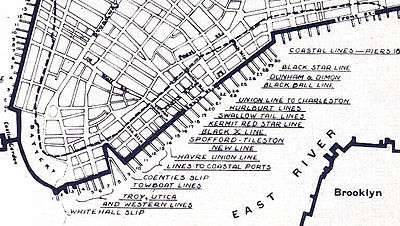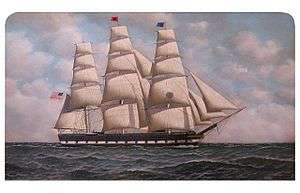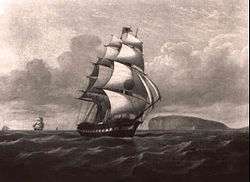Black Ball Line (trans-Atlantic packet)
The Black Ball Line (originally known as the Wright, Thompson, Marshall, & Thompson Line, then as the Old Line) was a passenger line founded by a group of New York Quaker merchants headed by Jeremiah Thompson, and included Isaac Wright & Son (William), Francis Thompson and Benjamin Marshall. All were Quakers except Marshall.[1]
| Partnership | |
| Industry | Shipping, transportation |
| Fate | Bankruptcy |
| Founded | 1817[1][note 1] in New York, United States |
| Defunct | 1878 |
| Headquarters | |
Area served | Transatlantic |

The line initially consisted of four packet ships, the Amity, Courier, Pacific and the James Monroe. All of these were running between Liverpool, England and New York City. This first scheduled trans-Atlantic service was founded in 1817. In operation for some 60 years, it took its name from its flag, a black ball on a red background.[2]
History

The Wright, Thompson, Marshall, & Thompson Line was founded in 1817 and began shipping operations in 1818. At some point in the line's history it became known as the Old Line and eventually became known as the Black Ball Line after the 1840s.[1] The Black Ball Line established the modern era of liners. The packet ships were contracted by governments to carry mail and also carried passengers and timely items such as newspapers. Up to this point there were no regular passages advertised by sailing ships. They arrived at port when they could, dependent on the wind, and left when they were loaded, frequently visiting other ports to complete their cargo. The Black Ball Line undertook to leave New York on a fixed day of the month irrespective of cargo or passengers. The service took several years to establish itself and it was not until 1822 that the line increased sailings to two per month; it also reduced the cost of passage to 35 guineas.
The sensation this created brought in competitors such as the Red Star Line, which also adopted fixed dates. The average passage of packets from New York to Liverpool was 23 days eastward and 40 days westward. But this was at a period where usual reported passages were 30 and 45 days respectively, while westward passages of 65 to 90 days excited no attention. The best passage from New York to Liverpool in those days was the 15 days 16 hours achieved at the end of 1823 by the ship New York (though often incorrectly reported as Canada).[3] The westward crossing had a remarkable record of 15 days 23 hours set by the Black Ball's Columbia in 1830,[4] during an unusually prolonged spell of easterly weather which saw several other packet ships making the journey in 16 to 17 days. Captain Joseph Delano was reported to be "up with the Banks of Newfoundland in ten days".[5][6]
.jpg)
In 1836 the Line passed into the hands of Captain Charles H. Marshall, he gradually added the Columbus, Oxford. Cambridge, New York, England, Yorkshire, Fidelia, Isaac Wright, Isaac Webb, the third Manhattan, Montezuma, Alexander Marshall, Great Western, and Harvest Queen to the fleet.[7]
The Black Ball Line is mentioned in several sea shanties, such as "Blow the Man Down," "Homeward Bound", "Bullgine Run", "New York Girls", and "Hurrah for the Black Ball Line."
List of Black Ball Line (USA) ships
| Year built | Name | Tonnage | Length | Beam | Shipyard | Remarks |
|---|---|---|---|---|---|---|
| 1807 | Pacific | A. & N. Brown, New York | Sold in 1819 and became a whaler[8] | |||
| 1816 | Amity | 382 (bm) | New York | stranded on 24 April 1824 in Manasquan | ||
| 1817 | Courier | 381 tons | 103'6'' | 29' | S. Wright, New York | Was a whaler from 1826 to 1861 and a part of the Great Stone Fleet during the Civil War[8] |
| 1817 | James Monroe | 424 tons | 118 ft | 28'3'' | A. Brown, New York | The first packet of the Black Ball liner to depart on time, 5 January 1818[8]; left the packet service in 1823 to the Cuban trade; ran aground in 1850 off the Tasmanian coast |
| 1819 | Albion | New York | wrecked off the coast of Ireland, near Kinsale, April 25, 1822, with a loss of forty-six lives | |||
| Liverpool | wrecked on her maiden voyage[8] | |||||
| 1822 | James Cropper | |||||
| 1832 | South America[8] | |||||
| 1843 | .jpg) Montezuma | 924 (bm) | William H. Webb, New York | wrecked on Jones Beach, Long Island, 18 May 1854.[9] | ||
| 1843 |  Yorkshire | 996 (bm) | William H. Webb, New York | in February 1862 lost on the trip from New York | ||
| 1845 | _(14595274508).jpg) Fidelia | 895 (bm) | William H. Webb, New York | |||
| 1845 | 1683 (bm) | William H. Webb, New York | In 1887 sold to Norway as Sovereign; burned while loading coal 20 March 1891 | |||
| 1846 | Columbia | 1050 (bm) | William H. Webb, New York | |||
| 1847 | Isaac Wright | 1129 (bm) | William H. Webb, New York | caught fire on 23 December 1858 on the Mersey and sank | ||
| Orpheus | ||||||
 New York | ||||||
| 1850 | Manhattan | 1299 BRT | William H. Webb, New York | broke out on 14 March 1863 Liverpool en route to New York; disappeared | ||
| 1851 | Isaac Webb | 1359/1497 BRT | William H. Webb, New York | went to the dissolution of the Black Ball Line for Charles H. Marshall & Co. and sank on 25 October 1880 | ||
| 1851 | Great Western | 1443 BRT | William H. Webb, New York | |||
| Eagle | ||||||
| Orbit | ||||||
| Nestor | ||||||
| William Thompson | ||||||
| Albion | ||||||
| Canada | ||||||
| Britannia | ||||||
| 1854 | 1383 BRT | sank 31 December 1875 after a collision, in the Irish Channel | ||||
| 1855 | James Foster, Jr. | 1410 BRT | William H. Webb, New York | was in 1881 as a Hudson sold to German owners | ||
| 1855 | Neptune | 1406 BRT | William H. Webb, New York | ran in April 1876 to the Nova Scotia coast and broken | ||
| 1860 | Alexander Marshall | 1177 BRT | William H. Webb, New York | sank 1869 in the North Atlantic |
Similar shipping lines
- In 1851 James Baines & Co. of Liverpool entered the packet trade using the same name and flag as the New York company, despite its protests. Thus, for about twenty years, two "Black Ball lines" under separate ownership were operating in direct competition on the transatlantic packet trade. James Baines & Co. also operated ships running between Liverpool and Australia, including famous clipper ships such as Champion of the Seas, James Baines, Lightning, Indian Queen, Marco Polo and Sovereign of the Seas.[1]
- The Saint John-Liverpool Packet Line which existed for a couple of years in the 1850s was also known as the Black Ball Line. It was managed by Richard Wright, St. John, and William and James Fernie, in Liverpool.[1]
Notes
- The company was founded in 1817. It wasn't until 1818 that it began shipping operations.
References
- http://www.bruzelius.info/Nautica/Ships/Owners/Old_Line.html
- Stephen Fox, Transatlantic: Samuel Cunard, Isambard Brunel, and the Great Atlantic Steamships, Harper Collins (2003) ISBN 0-06-019595-9, pp. 3–16 (introductory chapter on sailing packets)
- Cutler, Carl C. (1984). Greyhounds of the Sea (3rd ed.). United States Naval Institute/Patrick Stephens, Northants. p. 66.CS1 maint: ref=harv (link)
- Cutler 1984, pp. 410
- Gibbs, Charles Robert Vernon (1957). Passenger Liners of the Western Ocean: A Record of Atlantic Steam and Motor Passenger Vessels from 1838 to the Present Day. London: Staples Press. OCLC 225962096.
- Cutler 1984, pp. 65–68
- Clark, Arthur H. (1911). textsThe clipper ship era; an epitome of famous American and British clipper ships, their owners, builders, commanders, and crews, 1843-1869. G. P. Putnam's Sons. p. 41. Retrieved 1 April 2020.
- Strong, Charles (1957). The story of American sailing ships. New York, Grosset and Dunlap.
- https://wrecksite.eu/wreck.aspx?152045
External links

- A Tribute To A Dynasty: The Black Ball Line and The Pacific Northwest
- Transatlantic WNYC Reading Room
- Steamship Ticket for Passage of Mr. Nicholas Fish on the Packet Ship Yorkshire, 1859 at GG Archives

